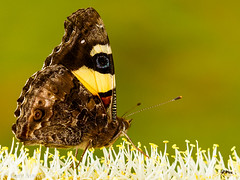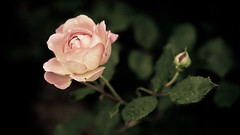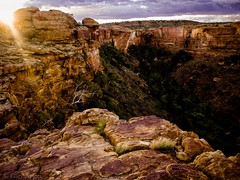I love the Olympus dSLR macro system introduced in Dec 2003 because:
- it’s relatively light for hand held use
- availability of swivel live preview LCD screens so you don’t have to get down on the ground – eg. Olympus E330, E30, E3 dSLRs
- a high optical quality macro lens – the ZD 50mm f/2.0 macro with circular aperture for nice bokeh, and edge to edge sharpness that is usually not found on full frame lenses
- availability of superb teleconverters to allow higher magnification whilst maintaining working distance
- availability of excellent complete ring flash and twin flash which share the same flash controller, and as is standard, provide full TTL auto exposure metering or full manual control as well as modeling lights, and for the twin lights you can control light ratio and importantly there are diffusers to improve the quality of the light
- the Canon ring flash is actually segmented tubes giving a poor catchlight
- Nikon don’t currently make a ring flash for their system
- whilst the small size of macro ring flashes are not adequate to create the beauty ring catchlight of large pro ring flashes, they make great shadowless fill-in flash for portraits as well as their use for almost shadowless macro shots
- it’s easy to use, particularly the flash module settings
- image stabilisation is available for all lenses when using an IS-capable body such as E510/520/E30/E3
- whilst Nikon make a VR macro lens, there are no image stabilised macro lenses available for Canon dSLRs
- ability to use almost any macro lens ever made (Nikon, Leica R/M, Carl Zeiss, Olympus OM,etc) with notable exceptions such as Canon EOS
- you can combine it with non-Olympus flashes in manual flash output mode by setting the Olympus macro flash to Manual mode (to switch off pre-flashes which prematurely trigger your other flashes), and use an optical trigger device on your other flashes

The system is capable of taking some great shots such as this one I took of a bee:
Hold on to your dreams:
BUT I believe its time to make it even better, so here are some of my suggestions:
First, the ZD 50mm macro lens:
- the AF can be a bit frustrating – time for SWD and compatibility with contrast-detect AF
- focus range switch to allow switchable settings such as 1:1 macro to 1m and 1m to infinity
- 1:1 macro instead of only 1:2 – could we dream of 1:0.5 even?
Next, make adapters to allow the existing macro flashes to attach to almost any lens.
- unfortunately Olympus designers seem to have been on hallucinogens making the current macro flash – the bayonet mount will only mount on certain lenses and even for the 50mm macro lens, one needs to buy a separate adapter.
- the bayonet fitting used to fit the original ZD 50-200mm lens but the new SWD version of this lens amazingly has an incompatible bayonet mount
- it’s time to make some adapters as is available in the Canon system so that these flashes can be mounted to various filter threads such as 58mm, 67mm, etc.
Now the macro flash system:
- the obvious need is to add capability for it to be a master controller for remote TTL flash so that one could control FL-36R or FL-50R flashes used to light the background
- it would be nice to be able to control light ratio of two halves of the ring flash – perhaps make the ring flash with 2 tubes as with Canon, but make them seamless so that you still get a full circle catchlight instead of the segmented ugly Canon ring light catch light
Lastly, perhaps some new macro lenses:
- a 1-5x macro lens similar to the Canon lens although these are unlikely to sell in large quantities given the difficulty in using such high magnifications, the absence of AF or ability to focus to infinity, but such macro capability is essential in a complete macro system
- a 100mm f/2.0 macro lens to provide a longer working distance and at the same time be a relatively compact, high quality f/2.0 lens for portraits, indoor action, astrophotography and whatever other applications one can think of
- currently, the ZD 50-200mm f2.8-3.5 SWD provides good macro performance at 1.2m close focus and 200mm focal length (400mm equivalent reach in 35mm terms), but I think a 100mm f/2.0 SWD macro would be a brilliant, even sharper lens in the pro line (rather than super-pro) and also compliment the current ZD 150mm f/2.0 lens which is probably due for a SWD upgrade
- Stan has reminded me of the Sigma 105mm f/2.8 macro lens but this does not appear to have the resolution wide open that I would like – see 105mm lens review.
More information on macrophotography here.












Gary
You undoubtedly know about the Sigma 105mm f/2.8 macro lens. It does have the limiter switch – very useful but is one stop slower than you’d like. I have one and I think it is a very good lens especially for the price. The “website” above is in one of my galleries – just flowers shot with close focusing lenses. Many were shot with the Sigma lens. I’ve left the full EXIF info which you might find useful.
Thanks Stan, I have always been a bit dubious of Sigma lenses as they seem to be just full frame lenses revised for Four Thirds rather than optimised for the smaller image circle.
The review below shows it is no where near as sharp as the 50mm f/2 especially wide open, which would limit its uses for me, although at f/8-11 its not bad.
http://fourthirds-user.com/2007/08/sigma_105mm_f28_ex_dg_macro_lens_review.php/a
I’m interested in adapting my olympus T8 macro flash for use along with ( new to the digital game ) a recently acquired Canon 50d. I understand that it theoretically can only work in manual mode, no problems with that. Any thoughts about this combo.
David M. Rosenstein says:
September 5, 2010 at 8:45 am
I’m interested in adapting my olympus T8 macro flash for use along with ( new to the digital game ) a recently acquired Canon 50d. I understand that it theoretically can only work in manual mode, no problems with that. Any thoughts about this combo.
Hi David, the old OM flashes should work well on any digital camera with a hotshoe including Canon dSLRs but as you say – only in manual exposure mode.
See also http://www.biofos.com/cornucop/flash_e.html
I would use a Wein Safe-Sync hotshoe adapter as trigger voltage appears to be a touch high at 15V.